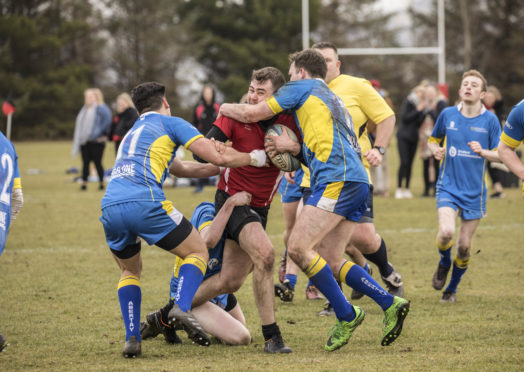A Dundee University study has called for all rugby players to wear headgear.
A team from the university’s Institute of Motion Analysis and Research (Imar) found wearing protective headgear could halve the impact on players’ heads.
The findings declared even the least effective device tested could make a significant difference in preventing head injuries, such as concussions.
Erin Frizell, the study’s lead author said risk of concussions could be reduced even further if rules relating to the thickness of headgear used during a game were relaxed.
Professor Rami Abboud, Imar director, said the study made a “compelling” case for players to be made to wear protective headgear at both amateur and professional levels.
He said: “The issue of head injuries in rugby, such as concussion, has become increasingly prevalent in recent years, with players often exposed to extreme forces.
“You cannot avoid injuries in contact sport and we are not saying that headgear would eradicate head injuries, but this research has shown just how significant a difference these products can make in helping to minimise the risk that rugby players face on the field.
>> Keep up to date with the latest news with The Courier newsletter
“You don’t want to go as far as American football with its hard helmets, which takes away from the essence of what rugby is, but there is a need for common sense to help minimise head injuries.
“These are relatively simple devices that can make a significant difference in protecting players, and yet some seem reluctant to wear them. If it became mandatory to wear these then the element of choice would be removed and further injuries could be prevented.”
Mid-priced products from seven manufacturers were used for the trial, with devices used to recreate forces of more than 103g.
Each of the tested devices showed a decrease in the force, ranging from 27 to 47 per cent.
Ms Frizzell, who is also a final-year medicine student, said she was surprised by the effectiveness of all the products tested.
She said: “Across the range the effectiveness was greater than I thought it would be, though the difference of 20% protection between the best and worst performing was also an eye-opener.
“The regulations set by World Rugby on headgear are very strict. They can’t be over a certain thickness, the materials they are made of have to be under a certain density, and they are marketed as a means of preventing scrapes and abrasions, not concussion.
“While the best performing device that we tested was 47% effective, it would be interesting to see if we could improve protection levels further if these rules were relaxed.”





